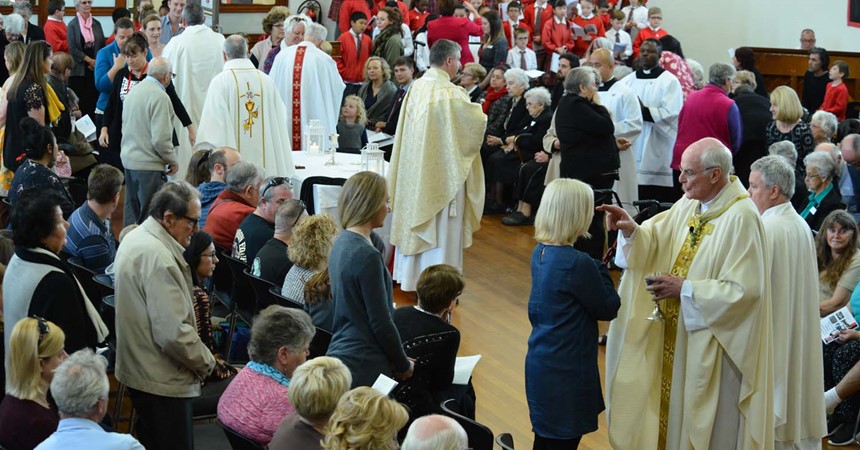Lent provides us with a wonderful opportunity to take the longer and deeper view. This week Nick steps back and invites us to consider the nature and meaning of the first level of liturgical participation. Once again take some space and ponder what this reflection reveals to you about our liturgy, your participation and your life.
Four things the bishops expect us to know about liturgical participation by Nick Wagner
In 1996, I went to a movie theatre in San Jose, California, to see Fargo. Fargo, as you probably know, is a black comedy focused on the investigation of a car salesman who hires two bumbling criminals to kidnap his wife in order to exhort ransom from his wealthy father-in-law.
What you have to know about the story is that it takes place in Minnesota. What you have to know about me is, I lived in Minnesota for six years and had just moved to California a few years before the movie came out.
In the theatre, there were two different groups laughing. The Californians were laughing at the obvious punch-lines and visual jokes. And a smaller group of us Minnesota transplants were laughing at the inside jokes and subtle wink-winks.
Both groups were, in a way, participating in the performance of the film in different ways. But even though we were all highly engaged, our participation was still pretty passive overall. None of us had speaking roles or production roles. In a sense, the camera operator was participating in the film more than anyone in the audience.
Sometimes I think parishioners think of their role in the liturgy to be something like watching a good movie. They feel involved, they feel like they participated, if the liturgy entertained them. But the bishops at the Second Vatican Council had something more than entertainment in mind when they called for “the full and active participation by all the people” as the aim to be considered before all else (see Constitution on the Sacred Liturgy, 14).
The bishops never explained fully what they meant by “participation.” But at the very minimum, they taught:
To develop active participation, the people should be encouraged to take part by means of:
acclamations,
responses,
psalms,
antiphons,
and hymns,
as well as by
actions,
gestures,
and bodily attitudes.
And at the proper times a reverent silence should be observed. (Constitution on the Sacred Liturgy, 30)
As we said earlier, based on the sacramental nature of the liturgy, we can discern three levels of active participation. And we started with the end in mind and looked at the third level, why we do what we do in the liturgy.
Now I want to go back to the beginning and look at the first level—what we actually do. We do not, like movie audiences, sit and watch. We acclaim, respond, and sing. We act, gesture, and move. As an assembly, the entire priesthood of Christ enacts worship.
This thing we do is a set of patterned or ritual behaviours. And every liturgical ritual has four characteristics.
- Everyone has a role
Liturgy, especially the Mass, is essentially a Thanksgiving dinner. When you go to your grandmother’s house for Thanksgiving, you have a role. Everyone at the dinner has a role. On the other hand, if you watch a movie about Thanksgiving, you have no role in the dinner. You are outside the action, looking in.
In a liturgy of the church, everyone participates. “Such participation by the Christian people as ‘a chosen race, a royal priesthood, a holy nation, a redeemed people’ (1 Pet. 2:9; cf. 2:4-5), is their right and duty by reason of their baptism” (Constitution on the Sacred Liturgy, 14).
- We do the same thing every time
Liturgy is not spontaneous. It is not made up new each time we celebrate. But that doesn’t mean it is boring or static. Think of a football or soccer game. Fans arrive knowing exactly what is going to happen. It is the same pattern, the same ritual, every time. But within that sameness, there is lots of room for surprise and novelty. In a sense, it is the strict rules of the game, the close confirmation to a repetitious pattern, that allows for surprise.
Sometimes people complain that liturgy is not reverent enough. When we hear that, it probably means that a given parish was deviating from the strict pattern of the rite. For liturgy (or football or soccer) to “work,” we have to take seriously the formal structure and performance of the ritual.
- Liturgy is a performance
“Performance” has several meanings, and we have to narrow down what we mean when we apply the word to liturgy. A movie or a play is a performance, but not in the way we mean it liturgically. A soccer game is also a performance. If we are watching the game on television, it is a performance in the way a movie is. If, however, we are among the players, the coaching staff, the trainers, or the officiants, we are actually part of the performance of the game. In this sense of the use of the word “performance,” two things are important to keep in mind.
First, liturgy is something we do. Liturgical performance does not exist in history or in ritual books. Liturgy only exists at the moment we are doing it.
Second, liturgy does something. Liturgy changes reality. The world existed in a particular way before the liturgy, and it is now different because we did the liturgy. Liturgy is not simply a way of communicating information about God or about a sacrament. Liturgy is always a life-changing encounter with the Holy. The scale of the change can be larger or smaller depending upon how well the liturgy was celebrated. “Good celebrations can foster and nourish faith. Poor celebrations may weaken it” (U.S. Bishops, Sing to the Lord: Music in Divine Worship, 5).
- Liturgy is rehearsal
The reason we are baptised is not so that we can go to Mass. The reason we are baptised is to go and make disciples. Liturgy rehearses us in the behaviours and attitudes we must master in order to make disciples.
In the liturgy, we practice listening to God’s voice, responding to God’s call in joy and thanksgiving, and learning how to sacrifice ourselves in the way Jesus did. Once we have all shared in that sacrifice, we are sent out on mission to invite others into God’s loving embrace. The actions we perform in the liturgy are meant to form us into the kind of people we need to be in the world so that others will know who God is.
Summary
The four characteristics (liturgy as a collective, repeatable performance that rehearses us for mission) make up the first level of participation that, at the very minimum, the bishops of the Second Vatican Council had in mind when they called for a restoration of the role of the people in the priestly offering of the liturgy.
There are two deeper levels of participation. We previously looked at the third and deepest level, why we do what we do in the liturgy. Together, we perform a ritual pattern that rehearses us for mission (first level) so that we can change the world into a place of God’s justice and mercy (third level).
The second level of participation is how exactly Christian ritual makes this change happen. That’s what we will look at next.
This article is based on Mark Searle’s book, Called to Participate: Theological, Ritual, and Social Perspectives, 18-27.
Source: Liturgy.Life - All right reserved. Used with permission.
Back to Maitland-Newcastle
What engaged you?
What meaning does it reveal for you and us together about the mode of our participation in liturgy?
What is God asking of you?

